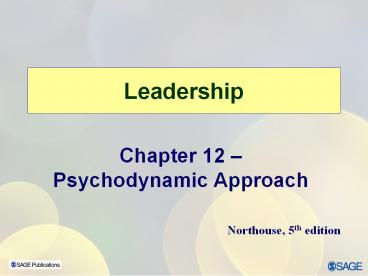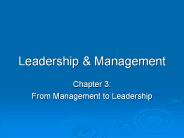Leadership - PowerPoint PPT Presentation
Title:
Leadership
Description:
Title: No Slide Title Author: Virginia Gregory Last modified by: UNCW Watson Created Date: 11/13/2000 9:29:08 PM Document presentation format: On-screen Show (4:3) – PowerPoint PPT presentation
Number of Views:120
Avg rating:3.0/5.0
Title: Leadership
1
Leadership
Chapter 12 Psychodynamic Approach
Northouse, 5th edition
2
Overview
- Psychodynamic Approach Perspective
- Eric Berne Transactional Analysis
- Sigmund Freud Personality Types
- Carl Jung Personality Types
- Sixteen Types and Leadership
- Dealing With Followers
- How Does the Psychodynamic Approach
- Work?
3
Psychodynamic Approach Description
- One fundamental concept underlies this approach
personality - A consistent pattern of ways of thinking,
feeling, acting - Affected by the environment, including people
- Characterized by tendencies or qualities
- a person may be shy, intelligent, rigid in
behavior - another person creative, independent,
spontaneous
4
Psychodynamic Approach Description
- Function of leaders To become aware of their
own personality type and the personalities of
followers - Underlying assumptions
- Personality characteristics of individuals are
deeply ingrained and virtually impossible to
change in any significant way - People have motives feelings that are
unconscious - Persons behavior results from observable
actions, responses AND from emotional effects of
past experience
5
Eric Berne and Transactional Analysis
- Transactional Analysis
- People have three ego states parent, adult,
child - Parent when a person thinks, feels behaves in
ways copied from his/her parents - Child thinking, feeling, behaving as one did as
a child - Adult thoughts, feelings, or behaviors that are
a direct result of current happenings - Key point people shift in out of the 3 ego
states
6
Transactional Analysis Further Development
- Parent child ego states subdivided
- Parent state controlling or nurturing
- Child state free child (FC) or adapted child
(AC) - AC a person conforms adapts to demands of
others - FC a person acts feels like an uninhibited
unsocialized child - Adult state current self
- Ego state is not the same as personality
- TA personality Egogram created by a person
shows their relative frequency in each ego state
7
Eric Berne and Transactional Analysis
CP critical parent NP nurturing parent A
adult FC free child AC adapted child
8
Transactional Analysis
- occurs when the ego states of 2 people
interacting is assessed - Complimentary interaction
- one person in a nurturing parent ego state
- other person in their adaptive child ego state
- Crossed transaction
- A leader in the adult ego state deals with
- A subordinate who responds from their free child
ego state with somewhat negative, rejecting input
from the leader - Effective leadership followership depend on two
or more people operating in the adult ego state
9
Eric Berne and Transactional Analysis
10
Eric Berne and Transactional Analysis
For a leader-follower dyad, the following
complementary transactions could occur
11
Eric Berne and Transactional Analysis
For a leader-follower dyad, there are a number of
possible crossed transactions
12
Sigmund Freud Personality Types
- Core personality
- Is inborn and instinctual
- Values, attitudes, beliefs overlaid on core
personality - Three personality types
- Erotic
- Obsessive
- Narcissist
- Additional type (Eric Fromm)
- Marketing
13
Sigmund Freud Personality Types
- Erotic
- Wants to love and be loved
- Wants group or team to become family
- Can be quite dependant needy
- Obsessive
- Prefers order stability
- Value maintaining status quo
- Living up to rules regulations of society or
organization - Strong conscience
- Can be very aggressive domineering
14
Sigmund Freud Personality Types
- Marketers
- Adapt readily to changes in society
organizations - Personal development being competent is valued
- Good at facilitating, networking
- Use process of collaboration to achieve consensus
15
Sigmund Freud Personality Types
- Narcissist
- Not egotistical or vain
- Takes pride in actual accomplishments
- Humor is important, often self-directed
- Has a clear vision of what needs to be done, but
- does not account for or consider others pursuit
of that vision
16
Sigmund Freud Personality Types
- Productive unproductive versions of
personality types - 5 key elements to productiveness
- Productive person is
- Free and not dependent
- Guided by reason
- Active or proactive
- Understands his/her own situation
- Has a purpose in life
17
Sigmund Freud Personality Types
- Productive unproductive versions of
personality types, contd. - Unproductive people are characterized as
- Limited averse to risk, irrational. Reactive,
superficial, aimless, uncommitted - Best personality type
- Productive narcissists
- Visionaries
- Able to motivate others to accept the vision
work toward it - Have strengths and weaknesses
18
Sigmund Freud Personality Types
19
Sigmund Freud Personality Types
- How to work with Narcissistic leaders (NL)
- Followers should
- know their own personality type
- Know NLs will not satisfy needs of others
- Need excellent knowledge of their own field
complementing NLs knowledge - Avoid getting ego-involved
- Protect image of the NL
- Productive Narcissist is needed in organizations
and work teams - Best as the leader of organizations in times of
crisis and change
20
Carl Jung Personality Types
- Jungs way of classifying people and their
personalities assumes - Human behavior is predictable and understandable
- People have preferences for how they think and
feel - Preferences become basis for how people work and
play
21
Carl Jung Personality Types
- Four dimensions important in assessing
personality - Where a person derives his/her energy
- internally or externally
- Way in which a person gathers information
- precise, sequential way or more intuitive
random way - Way in which a person makes decisions
- rationally factually or in a subjective,
personal way - Differences between a person who plans is
organized or, one who is more spontaneous
pliant
22
Carl Jung Personality Types
- Classification of Types
- Extraversion versus Introversion if person
prefers to derive energy externally or internally - Sensing versus Intuitive if person prefers to
gather information in a precise or insightful way - Thinking versus Feeling if person prefers to
make decisions rationally or subjectively - Judging versus Perceiving if person prefers to
live in an organized or spontaneous way
23
Carl Jung Personality Types
- Combinations of the 4 dimensions
- 16 combinations
- Each combination is considered a type
- The 16 combinations are
- ESTP, ISTP, ESFP, ISFP, ESTJ, ISTJ, ESFJ, ISFJ,
ENTJ, INTJ, ENTP, INTP, ENFJ, INFJ, ENFP, INFP - A leader should identify his/her own style and
concentrate on understanding it
24
Carl Jung Personality Types
- Functions and Preferences
- Extraversion and Introversion
- Extraversion is a preference for obtaining
information, inspiration, and energy from outside
the self - Talk a great deal
- Desire contact with others
- An introvert uses her/his own ideas and thoughts
doesnt need external stimulation - Listen not talk
- Constant contact with others is draining
25
Carl Jung Personality Types
- Functions and Preferences
- Sensing and Intuition
- Sensors collect data through their senses
thinking revolves around facts practical
matters - detail oriented, happy to deal with real world
- focus on what they can see, hear, touch, smell,
and taste - Intuitives tend to be much more conceptual and
theoretical - Common everyday experience bores them
- Prefer to be creative, apply ingenuity to a
problem
26
Carl Jung Personality Types
- Functions and Preferences
- Thinking and Feeling
- Thinkers use logic, strive for objectivity, and
are analytical - Often seem detached, uninvolved with people
- Prefer guiding actions on basis of possible
results - Feelers tend to be more subjective, seek harmony
with others, take into account the feelings of
people - Are more involved with others at work or
elsewhere - Seen as considerate and humane
27
Carl Jung Personality Types
- Functions and Preferences
- Judging and Perceiving
- Judgers prefer structure, plans, schedule, and
resolution - decisive and deliberate quite sure of their way
of doing things - Perceivers tend to be much more flexible,
adaptable, tentative, and open ended - are spontaneous
- do not take deadlines seriously may change their
minds and decisions without difficulty
28
Carl Jung Personality Types
- Types and Leadership
- Kroeger Theusen (2002)
- 8 functions to assess and describe leadership
strengths and weaknesses - Does not suggest that 1 type is better or worse
- However, research does show a preference for
leaders who are - TJ - thinker-judgers 69.9-85 of those surveyed
chose this type as the best for middle upper
managers and executives
29
Carl Jung and Personality Types
Psychological Preferences and Leadership
30
Sixteen Types and Leadership
Psychological Types and Leadership
31
Dealing With Followers
- Kroeger Theusen (2002)
- developed a matrix showing how leaders should
deal with subordinates of the same or different
dimensions - Extrovert leader interacts with an introvert
follower - Leader likes to talk and often dominates the
discussion - Follower needs time to think things through,
likes to explain his/her response without
interruption - Solution leader needs to back off during the
conversation or may suggest they get back
together in an hour or so to go over what needs
to be done - Understanding awareness of psychological types
can be useful in communicating effectively
32
How Does the Psychodynamic Approach Work?
- Focus of Psychodynamic Approach
- Strengths
- Criticisms
33
Psychodynamic Approach
How does it work?
- Primary consideration raise awareness of
leaders and followers - to their own personality types
- implications of these types on their work
relationships - Assessments accomplished
- Psychological types MBTI or similar method or
questionnaires - Ego states TA model, ego states is used
34
Psychodynamic Approach
How does it work?
- Application determine the most favorable kind
of work for an individual based on preferences in
terms of - gathering information
- making decisions
- structuring work efforts
- dealing with people
35
Strengths
- Results in an analysis of the relationship
between a leader and a follower - Is based on a search for universal truth
- Emphasizes the leaders need for insight
- Discourages manipulative techniques in leadership
36
Criticisms
- Based on the psychology of the abnormal rather
than the normal - The MBTI may have reliability or validity
problems - TA has limitations as there is no standardized
assessment each person evaluates own ego states - Focuses primarily on personalities of leader
followers that dictate nature of relationship
between them - Rejection of notion that emotional reactions
occur toward leaders, followers coworkers, and
that those reactions arise from predispositions
in individuals - Does not lend itself to traditional training
paradigm































